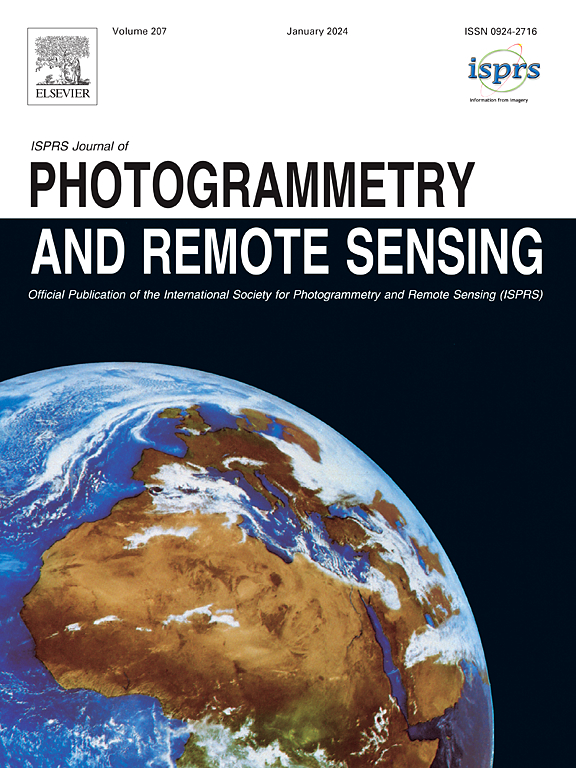Precise and efficient high-frequency trajectory estimation for LiDAR georeferencing
IF 10.6
1区 地球科学
Q1 GEOGRAPHY, PHYSICAL
ISPRS Journal of Photogrammetry and Remote Sensing
Pub Date : 2025-03-26
DOI:10.1016/j.isprsjprs.2025.03.007
引用次数: 0
Abstract
Laser scanners mounted on moving platforms allow for efficient large-scale 3D mapping using light detection and ranging (LiDAR). Because the laser scanner is moving with respect to the earth, its trajectory (position and orientation over time) must be known in order to georeference the scanner measurements to an earth-fixed coordinate system. This is commonly realized through integration with satellite and inertial navigation systems. Sensor fusion algorithms, whether filter-based or adjustment-based, then fuse the navigation data to obtain an estimate of the platform trajectory. Errors in this trajectory cause errors in the 3D point cloud through the georeferencing process. Most processing workflows therefore include a step which optimizes the trajectory based on the LiDAR data itself. In this contribution, we focus on two related aspects of trajectory estimation and LiDAR georeferencing: Firstly, we analyze the impact of high-frequency trajectory dynamics, which cause oscillating errors in the trajectory and negatively impact point cloud precision if the inertial sensors’ sampling frequency is too low to properly resolve them. This implies the necessity of recording and processing inertial measurements at a sufficiently high frequency, which can drastically increase computational effort of the sensor fusion algorithm, especially for adjustment-based approaches. Thus, secondly, we propose a method for performing adjustment-based trajectory estimation with high-frequency inertial measurements which efficiently uses downsampled low-frequency inertial measurements within the adjustment while recovering the high-frequency trajectory dynamics from the original measurements. Analysis and processing are performed for two separate datasets acquired with two different platforms, a quadcopter uncrewed aerial vehicle (UAV) and a crewed fixed-wing aircraft. For the former, we demonstrate through analysis of point spread on planar surfaces that a 200 Hz sampling frequency for the inertial measurements is insufficient and leads to reduced point cloud precision. In both cases, the proposed methodology is shown to precisely recover the high-frequency trajectory while drastically reducing memory usage and runtime compared to performing the adjustment with the high-frequency inertial measurements.
用于激光雷达地理参考的精确高效高频轨迹估计
安装在移动平台上的激光扫描仪允许使用光探测和测距(LiDAR)进行有效的大规模3D绘图。由于激光扫描仪是相对于地球移动的,因此必须知道它的轨迹(位置和方向随时间的变化),以便将扫描仪的测量结果与地球固定的坐标系进行地理参考。这通常是通过卫星和惯性导航系统的集成来实现的。传感器融合算法,无论是基于滤波还是基于调整,然后融合导航数据以获得平台轨迹的估计。该轨迹的误差会通过地理参考过程导致三维点云的误差。因此,大多数处理工作流程都包含一个基于LiDAR数据本身优化轨迹的步骤。在这篇论文中,我们重点研究了轨迹估计和激光雷达地理参考的两个相关方面:首先,我们分析了高频轨迹动力学的影响,如果惯性传感器的采样频率太低而无法正确解决这些问题,则会导致轨迹振荡误差并对点云精度产生负面影响。这意味着必须以足够高的频率记录和处理惯性测量,这可能会大大增加传感器融合算法的计算工作量,特别是对于基于调整的方法。因此,其次,我们提出了一种基于高频惯性测量进行平差弹道估计的方法,该方法在平差期间有效地利用下采样的低频惯性测量,同时从原始测量中恢复高频弹道动力学。分析和处理由两种不同平台,一种四轴飞行器无人驾驶飞行器(UAV)和一种有人驾驶的固定翼飞机获得的两个独立数据集。对于前者,我们通过分析平面上的点扩展证明了200 Hz的采样频率不足以用于惯性测量,并导致点云精度降低。在这两种情况下,与使用高频惯性测量进行调整相比,所提出的方法可以精确地恢复高频轨迹,同时大大减少内存使用和运行时间。
本文章由计算机程序翻译,如有差异,请以英文原文为准。
求助全文
约1分钟内获得全文
求助全文
来源期刊

ISPRS Journal of Photogrammetry and Remote Sensing
工程技术-成像科学与照相技术
CiteScore
21.00
自引率
6.30%
发文量
273
审稿时长
40 days
期刊介绍:
The ISPRS Journal of Photogrammetry and Remote Sensing (P&RS) serves as the official journal of the International Society for Photogrammetry and Remote Sensing (ISPRS). It acts as a platform for scientists and professionals worldwide who are involved in various disciplines that utilize photogrammetry, remote sensing, spatial information systems, computer vision, and related fields. The journal aims to facilitate communication and dissemination of advancements in these disciplines, while also acting as a comprehensive source of reference and archive.
P&RS endeavors to publish high-quality, peer-reviewed research papers that are preferably original and have not been published before. These papers can cover scientific/research, technological development, or application/practical aspects. Additionally, the journal welcomes papers that are based on presentations from ISPRS meetings, as long as they are considered significant contributions to the aforementioned fields.
In particular, P&RS encourages the submission of papers that are of broad scientific interest, showcase innovative applications (especially in emerging fields), have an interdisciplinary focus, discuss topics that have received limited attention in P&RS or related journals, or explore new directions in scientific or professional realms. It is preferred that theoretical papers include practical applications, while papers focusing on systems and applications should include a theoretical background.
 求助内容:
求助内容: 应助结果提醒方式:
应助结果提醒方式:


